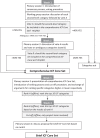ICF Core Sets for the assessment of functioning of adults with cerebral palsy
- PMID: 34800032
- PMCID: PMC9299033
- DOI: 10.1111/dmcn.15104
ICF Core Sets for the assessment of functioning of adults with cerebral palsy
Abstract
Aim: To report on the results of the online international consensus process to develop the comprehensive and brief International Classification of Functioning, Disability and Health (ICF) Core Sets for adults with cerebral palsy (CP).
Method: An online iterative decision-making and consensus process involved 25 experts, including clinicians and researchers working with adults with CP, an adult with CP, and the parents of adults with CP from all six regions of the World Health Organization. The most relevant categories were selected from a list of 154 unique second-level candidate categories to develop the ICF Core Sets for adults with CP. This list resulted from evidence gathered during four preparatory studies, that is, a systematic literature review, a qualitative study, an expert survey, and an empirical study.
Results: The consensus process resulted in the comprehensive ICF Core Set containing 120 second-level ICF categories: 33 body functions; eight body structures; 50 activities and participation; and 29 environmental factors, from which the most essential categories, 33 in total, were selected for the brief ICF Core Set. For body functions, most of the categories were mental functions and neuromusculoskeletal and movement-related functions. Body structures were mostly related to movement. All the chapters of the activities and participation component were represented, with mobility and self-care as the most frequently covered chapters. For environmental factors, most of the categories addressed products and technology and services, systems, and policies.
Interpretation: The comprehensive and brief ICF Core Sets for adults with CP were created using a new online version of an established ICF Core Set consensus process. These Core Sets complement the age-specific ICF Core Sets for children and young people with CP and will promote standardized data collection worldwide.
© 2021 The Authors. Developmental Medicine & Child Neurology published by John Wiley & Sons Ltd on behalf of Mac Keith Press.
Figures


Comment in
-
Relevance and applicability of ICF Core Sets for adults with cerebral palsy in low- and middle-income countries.Dev Med Child Neurol. 2022 May;64(5):533. doi: 10.1111/dmcn.15113. Epub 2021 Nov 18. Dev Med Child Neurol. 2022. PMID: 34796489 No abstract available.
References
-
- Sellier E, Platt MJ, Andersen GL, Krägeloh‐Mann I, De La Cruz J, Cans C, et al. Decreasing prevalence in cerebral palsy: a multi‐site European population‐based study, 1980–2003. Dev Med Child Neurol. 2016;58:85–92. - PubMed
-
- Oskoui M, Coutinho F, Dykeman J, Jetté N, Pringsheim T. An update on the prevalence of cerebral palsy: a systematic review and meta‐analysis. Dev Med Child Neurol. 2013;55:509–19. - PubMed
-
- Rosenbaum P, Paneth N, Leviton A, Goldstein M, Bax M, Damiano D, et al. A report: the definition and classification of cerebral palsy April 2006. Dev Med Child Neurol Suppl. 2007;109:8–14. - PubMed
Publication types
MeSH terms
LinkOut - more resources
Full Text Sources
Medical
Miscellaneous

